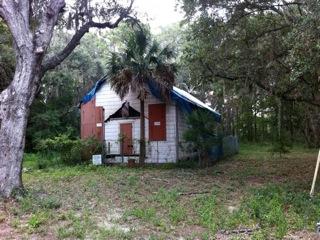
Section Branding
Header Content
Hidden History Of One-Room School
Primary Content

The Harrington School doesn’t look like much. The abandoned building is surrounded by a rusty metal fence. The roof has holes in it, some wooden siding has fallen off, and it badly needs a coat of paint. The school looked so dilapidated that two years ago, community leaders and even the local historical society had given up hope it could be saved.
“They said that the building just wasn’t worth saving, and you could just look at it and tell it was going to fall any minute, so let’s just tear it down.”
Amy Roberts has lived on St. Simons Island all her life, and has fond memories of the school. She attended first grade there in 1953, and remembers lessons in and out of the classroom.
“How many children can say that they went to school and it was out in the yard and they saw a caterpillar do the cocoon thing, and then you waited so many days and then you saw a butterfly.”
Harrington was built in 1925 as a one-room schoolhouse for St. Simons’ African-American community, since segregation laws of the time banned black students from attending school with white children. Hundreds of the island’s black children went to elementary school at Harrington until 1954, when the Supreme Court ruled U.S. classrooms had to be integrated. Students were transferred to the island’s other, formerly whites-only, elementary school. The building continued to be used for social activities and a day care center, but by 1970, it was abandoned.
Soon it became an eyesore, and developers began to eye the property.
Concerned that the school might be torn down, Amy Roberts started the African-American Heritage Coalition to preserve the island’s heritage.
“If it’s not done, if it’s not saved, then eventually you would not know that we existed here on St. Simons. Everything of African-American heritage has been torn down.”
In 2009, despite years of effort by the coalition, Harrington was slated for demolition. But weeks before demolition, Patty Deveau, a historian who lives on St Simons, took a closer look at the building. She realized the old schoolhouse was part of a bigger piece of history: a massive 1920s philanthropic movement called the Rosenwald Fund.
Its purpose, explains Georgia historian Jeanne Cyriaque, was to promote small community schools as a way for African-Americans to get an education.
"At the very core of that movement was the involvement of the community, sympathetic whites, and philanthropy, merging together to do what today we’d call partnerships.”
Julius Rosenwald, the man behind that partnership, was head of the retail giant Sears, Roebuck and Co. In 1915, he donated start-up money to encourage African-American communities to build their own schools. By the late 1920s, the Fund had contributed to more than 5,000 educational buildings in 15 states across the South and one in three rural black children was attending a Rosenwald school.
There’s no record of whether the Harrington School actually was a Rosenwald school, but Cyriaque says its design and community location make it a model of what the Fund was trying to do.
“This particular school kind of embodies to me what was going on with the communities at that time, because in many African-American communities, it was African-American families that gave land for these schools to be built,” Cyriaque says.
Besides land, African-American communities donated labor and materials, and the county government contributed teachers and money.
Since it was part of both the island’s African-American heritage and the Rosenwald legacy, it was now doubly important to save the Harrington School.
So preservation architects were asked to give the building a second look. Amy Roberts- and everyone else - were surprised by their findings.
“And they went through it and they talked about how sound it was; and how, you know, they’d never seen anything like this. I mean, it was, like, in great shape," says Roberts.
Now, architects are developing restoration plans and the community is making suggestions about how the building will be used. Roberts dreams about what the new Harrington School will be like someday.
“It’s gonna be a lot of things. It could be a building that may be a place where school kids can come and visit and find out what life was like in a one-room schoolhouse. It would also let folks know that there were three African communities on St. Simons and talk about those three communities.
And maybe there’ll be a caterpillar or two in the front yard for a science lesson.
Tags: school, St. Simons Island, Historical School, Historical Site
